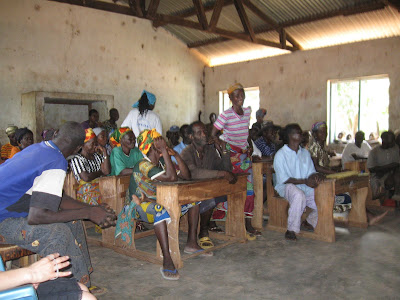
The carpentry class at the Wa School for the Deaf

The children are choosing a sign for Maria`s name.

The dormitory at the Wa School for the Deaf

Girls start at a young age carrying things on their heads.
July 20
We visited three schools today; the Wa Residential School for the Deaf (SFD), Tawonchelle Junior High and PISI Catholic Primary School. We were touched by all the children, especially the children at the SFD. Some of them are profoundly deaf, while others have some hearing and would benefit from hearing aids, if it were only possible to get them. We were told that years ago a French organization donated hearing aids to the school, but those hearing aids are no longer working. With their teacher`s help, the children gave each of us a sign for our names. The school also offers vocational training through support from Chalice, so we visited the carpentry class which had moved outside, the weaving, sewing and craft class. We were able to purchase some of the goods made by the students: beautiful bracelets, placemats and a bolt of hand-woven material.
We arrived at PISI at break time. The teachers were under a tree marking exams and the children were playing. I went with some students to their classroom to see their work. Their classroom looked identical to all the other classrooms I have seen. It was bare with a concrete wall blackboard and two person desks and benches set in rows facing the front. When I asked a teacher what student materials she used she said that they have a shortage of textbooks, and for every subject they share 30 textbooks among the 120 Primary 4 (P4) pupils. She also said that their textbooks were stored in the Office, and pupils were not allowed to take them home as they would get damaged.
When we arrived at the Tawonchelle JH School a group was working on installing a short piece of eaves-trough to collect water into a large black rain barrel. This is another Chalice project. Chalice has a school reforestation programme and is planting trees to prevent the school roof from blowing off during storms. Rain water collected in the barrel will be used to water the newly planted trees during dry spells.

Clothing, including school uniforms are hand sewn by a seamstress. The cloth is purchased at the market. At this school students are provided with lunch.

The eaves-trough and rain barrel.

The new Tawonchelle JH school. The children gather inside the stone circle for their morning commencement and prayer.

The old Tawonchelle school.
Chalice School Projects as reported by Philip
-The support areas given to sponsored children in the SFD sub-site, which comprises five schools at the moment are: uniform and shoes, school fees, text books, reading materials, supplementary feeding, and registration for the whole family in the National Health Insurance Scheme (NHIS) which provides free medical care.
· Under the SFD sub-site children are also sponsored in three other schools- Baaleyiri, Loggu Sagu and St. Andrews Catholic Schools.
· In Lassia Tuolu Main sub-site, there are eleven sub-sites.
· In Nandom (MBB), Chalice has four schools in which children are sponsored. The support areas are the same as those of SFD.
· Lassia Tuolu Main provides Parent Group Literacy classes, School Days, school rehabilitation, furniture for pupils and school reforestation programmes.























